![]()


Introduction
1. "The New Found Land" ◊ 2. "Home from Home"
3. "Making a Revolution" ◊ 4. "Inventing a Nation"
5. "Gone West" ◊ 6. "A Firebell in the Night"
7. "Domesticating a Wilderness" ◊ 8. "Money on the Land"
9. "The Huddled Masses" ◊ 10. "The Promise Fulfilled and the Promise Broken"
11. "The Arsenal" ◊ 12. "The First Impact"
13. "The More Abundant Life"
![]()
"You know, when I told an old Southerner, a friend of mine, that I was going to try to tell my version of American history in thirteen hours, he said 'Better talk fast, boy.'"
Writer/Narrator: Alistair Cooke.
Producer: Michael Gill.
Associate Producer: Ann Turner.
Historical Advisor: Sir Denis Brogan.
Music: William Davies.
In 1972, a program called Masterpiece Theatre on PBS was just beginning to make an impression on American audiences. Begun in 1971, the series of English costume dramas (at least at first) was hosted by journalist Alistair Cooke, who also wrote and performed the long-running "Letter from America" feature on BBC radio (which ended just weeks before Cooke's death in 2004). Cooke had been living in the United States since the 1930s and had a unique perspective on American history which was explored in this 13-part series, produced by the BBC and first telecast on NBC television in the fall of 1972 and sponsored with limited commercial interruption by Xerox, the first of a series of programming produced to celebrate the Bicentennial.
America was an immediate critical success. The series won a George Foster Peabody Award for excellence in television programming and almost immediately was repeated on PBS stations in two formats: the original hour format and a half-hour format.
Ironically, in the United States the series was only released on video to educational institutions, mostly libraries. There were no public sales, which, for my own part, I thought was a shame. I obtained my own copies by duping library copies, but would have bought the series had it been sold. The series is finally available on DVD, however, only in Region 2. It is available from the BBC Shop, Amazon.co.uk, and several other vendors (do a Google search on +cooke +america +dvd). (BBC Shop and vendors like Play.com only ship to the U.K. and Europe.)
Although the last part is sadly out of date, this series cries for a release to DVD in Region 1. It presents history in an informative and absorbing manner, and Cooke's own commentary is quite entertaining and many times enlightening. He makes the personalities of the past come alive and his history is more that of the people that lived it than rote dates and facts. Perhaps some historian, or someone like Russell Baker, who replaced Cooke as host of Masterpiece Theatre, could be called upon to do some type of introduction to the final part?
What follows is a summary of the episodes; following the summaries I have occasionally noted items of interest, or injected a personal note, as this is one of my favorite television series of all time.
![]()
 |
Episode 1 Directed by Michael Gill "For hundreds of centuries, and long after man had settled in the land masses of Europe, Asia, and Africa, this continent was unknown to any human being." |
Opening with a panorama of the American countryside and the faces of the Native American population that later crossed the presumptive land bridge from what is now known as Siberia to the present state of Alaska, Cooke's introduction segues into the "discovery" of America. While touching on other claims, he concentrates on Christopher Columbus' voyage to find a easier route to the Maluccas (the Spice Islands), including a profile of the mariner himself and a tour of a reproduction of the Santa Maria.
Cooke next discusses the outrages perpetrated on the native population by Spanish fortune-hunters looking for mythic cities of gold (contrasting this briefly with the arrival of the French, who treated the natives with more care). The history of the rock fortress of Acoma is detailed up to the present day, including its final siege by the Spanish 59 years after Coronado's first exploration.
Spanish legacies such as the ranch culture and the cultivation of corn are examined before continuing on to the French voyaguers and the beaver trade. LaSalle's epic expedition from Canada to the mouth of the Mississippi is chronicled, and the following establishment of waystations and towns along the rivers, where the Missouri town of St. Genevieve, Missouri, is profiled. The Catholic influence of both the French and Spanish is touched on, showing a Spanish-built church now attended almost solely by the Papago tribe.
Cooke finishes his tour of Spanish and French America in New Orleans, touching on the one French influence that almost every American knows, "the only French God in the American pantheon," the Marquis de Lafayette.
Locations:
Acoma Indian Reservation, New Mexico
Mescalero Apache Indian Reservation, New Mexico
Santa Fe, New Mexico
El Morro, New Mexico
Canyon de Chelly, Arizona
San Xavier del Back Mission, Arizona
Belloia Ranch, Arizona
Falcon Valley Ranch, Arizona
St. Genevieve, Missouri
San Juan Bautista, California
New Orleans, Louisiana
Jamestown, Virginia
New York City
Quebec Province, Canada
Barcelona, Spain
_________________________________________ This is a very strong opening to the series, with a view of how the unexplored continent must have looked to the Spanish and French explorers, especially the "endless lunar landscape" of the Western canyons. (The moody music accompanying the latter scenes is especially evocative.)
PERSONAL NOTE ON A PERSONAL SERIES:
![]()
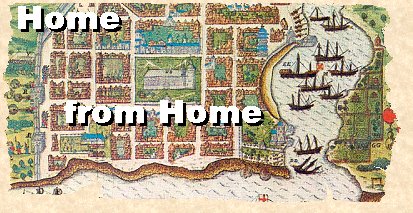
|
Episode 2 Directed by Ann Turner "'Being thus arrived in a good harbor and brought safe to land, they fell upon their knees and blest the God of Heaven who had brought them over the vast and furious ocean and delivered them from all the perils and miseries thereof, again to set their feet on the firm and stable earth, their proper element.'" |
(Note: The title of this episode is often mistakenly cited as "Home Away from Home.")
Locations:
Colonial National Park, Jamestown, Virginia
Colonial Williamsburg, Virginia
Shirley Plantation, Charles City, Virginia
Swanson Farm, Disputanta, Virginia
Adam Thoroughgood House, Norfolk, Virginia
Charles Towne Landing, Charlestown, South Carolina
Drayton Hall and Miles Brewton's House, South Carolina
Middletown Place and Stableyards, South Carolina
Cape Cod National Seashore
Rebecca Nurse House, Danvers, Massachusetts
Heritage Foundation, Deerfield, Massachusetts
Old Ship Church, Hingham, Massachusetts
John Whipple House, Ipswich, Massachusetts
Provincetown Fishermen's Cooperative, Massachusetts
Old Sturbridge Village, Massachusetts
Parson Capen House, Topsfield, Massachusetts
Intervale Farm, Westhampton, Massachusetts
Old Newgate Gaol, Connecticut
The Brick Meeting House, Calvert, Maryland
Newcastle, Delaware
Philadelphia, Pennsylvania
Middle Temple Hall, London
Tower of London
Groton and Lavenham, Suffolk, England
_________________________________________ Take note of Cooke's commentary about the Puritans; it reappears in "The Promise Fulfilled and the Promise Broken."
PERSONAL NOTE ON A PERSONAL SERIES:
![]()

|
Episode 3 Directed by Michael Gill "Every day in Moscow, the Russians and the tourists troup past the guards at the Tomb of Lenin and pause to look down on the corpse of the father of the revolution. Presumably they do so without a shudder for the body has been preserved by a special process for nearly half a century. These people, however, are not in Moscow. They're in Washington. They're looking at something which to Americans is an equally sacred icon. It is the birth certificate of the United States of America, the Declaration of Independence." |
Seguing from a line of tourists at the National Archives, Cooke outlines the signers of the Declaration and how unlikely the idea of revolution, the sentiments in the Declaration, and even the signers as revolutionaries were.
The seeds of the Revolution are laid when the French colonies to the west try to expand eastward. Thus the French and Indian War was born, George Washington sees his first action, and Fort Ticonderoga, visited by Cooke, is built. When the war is over, the British expect the colonies to pay expenses and for troops to patrol the frontier; revenue taxes and economic hard times, plus dreams of the frontier, "unite the colonies in righteous indignation," fanned by troops of soldiers and General Gage as colonial governor of Massachusetts.
Cooke discusses the fact and fiction of Boston Massacre and its consequences, including the Boston Tea Party, with a visit to Old South Meeting House. An explanation of the Committees of Correspondence brings us to Williamsburg, Virginia for a tour of the town, the Governor's Palace, and the Raleigh Tavern, where Virginia's revolutionary meetings were held and extrovert Patrick Henry becomes the trumpeter of the Revolution when the Port of Boston is closed by the British.
The Revolution breaks out in earnest with the battles at Lexington and Concord, and the American army is a scruffy conglomeration of working class men against trained British troops. The colonists main advantage: trained marksmen of the frontier used to hunting for survival with the "rifled" firearms, exhibited by Cooke, created by German craftsmen in Pennsylvania. Guerilla warfare also demoralizes the British.
The appointment of a Southerner, George Washington, profiled next from his home in Mount Vernon, as commander of the army brings the Southern colonies into the fight. Washington's stanchness holds the starving and struggling army together until French and Polish support comes. Eventually the Revolution is won.
Locations:
National Archives, Washington, DC
Fort Ticonderoga, New York
Old South Meeting House, Boston, Massachusetts
Colonial Williamsburg, Virginia
Minute Man National Park, Concord
National Rifle Association, Washington, DC
Mount Vernon, Virginia
Valley Forge State Park, Pennsylvania
National Capital Parks, Washington, DC
_________________________________________ Old home week: I had been to many of the places visited by Cooke. Also featured are a couple of "protest songs" from the Revolutionary era; fascinating.
PERSONAL NOTE ON A PERSONAL SERIES:
![]()

|
Episode 4 Directed by Michael Gill "Washington has been called, among other things, a city of Greek wedding cakes. They celebrate the conviction of the Founding Fathers that what they were building was the first modern republic worthy of Ancient Greece. What they could not anticipate was the flood of democracy that would 'rough up' the symmetry of their new institutions." |
The treaty ending the American Revolution leaves a bitter taste in British mouths especially when France and Spain also demand pounds of flesh. Loyalists are treated shamefully, chivvied into exile in England, the West Indies, or Canada while the patriots celebrate.
But the "united states" soon separate into individual colonies, quarrelling, and the Articles of Confederation are overridden with a need for a national Constitution. Cooke visits Philadelphia's Independence Hall, which hosted the Constitutional convention with unlikely participants: wealthy educationed landowners and professionals, men against total democracy.
No past government structure suited them, so they set out to invent their own, first determining what they did not want. Today's political campaigns echo the precepts they set down over 200 years ago.
Debates boiled down to proponents of a strong central government (led by Alexander Hamilton) versus a limited central government with most powers given to the state governments (led by George Mason of Virginia). The moderates in the group, led by James Madison, advocated a balance between both representations. This was adapted.
Cooke then speaks about the third addition to the Government that balanced the laws of the land against the desires of the people in a visit to the Supreme Court, the totally new invention of the Constitutional Convention. From France, Thomas Jefferson continually urges a Bill of Rights, and the original ten are added within four years. Jefferson's home life in Monticello is profiled, along with his Renaissance interest in all things and his belief in the yeoman farmers of the American nation.
It would be farmers who crossed the mountains into fresh fertile land who expanded the United States and changed the original conception of the republic, but unlettered folk a far cry from educated men like Jefferson at Monticello.
Locations:
Department of State, Washington, DC
Independence National Historial Park, Philadelphia, Pennsylvania
State House, Boston, Massachusetts
The Capitol, Washington, DC
Monticello, Virginia
Great Smoky Mountains National Park, Tennessee
_________________________________________ Cooke did a better job of summarizing the roles of the different branches of Government than any of my history teachers did, especially in his emphasis of the Supreme Court.
PERSONAL NOTE ON A PERSONAL SERIES:
![]()
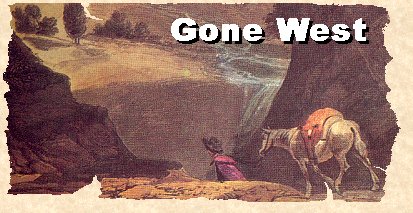
|
Episode 5 Directed by Tim Slessor I don't think anyone needs to be told we're in the American West. We happen to be up in a windy mountain valley, 8,500 feet up in the Sierra Nevada among the ghostly remains of an old mining town that struck it rich in 1876. We could be in any number of places between the Rockies and the Pacific, because the 'West' is not only a place, it's a state of mind, the idea of Eldorado, of getting away from it all, of leading the new life under the big sky." |
The ghost town of Bodie, California, opens an episode about the West, both as a place in the American experience and as a concept of freedom and new chances. The first frontier was the west side of the Appalachians, where Cooke visits a cave used as a home base by Daniel Boone; others explored the area after the American Revolution, following the discovery of a gap through the mountains by an English doctor who named the route after the Duke of Cumberland. So many explorers disappeared forever into the wilderness that "gone west" became synonymous for death.
One of the explorers' needs was salt, something Boone was renown for being able to find. Cooke shows us one area, a brine lake that attracted prehistoric mammals. Here and in similar sites the rough-and-ready settlers made homes. Part of the original Louisiana Purchase, this land consisted of one third of the present United States, a purchase made (at 4 cents an acre) by Thomas Jefferson without Congressional permission, after Napoleon lost Santo Domingo and wanted no more North American involvments. The vast territory was explored and chartered by Meriwether Lewis and William Clark, helped by an Indian woman named Sacajawea.
Once the land was "free" and explored, the settlers now wanted the Indian inhabitants to leave so that they could farm the fertile lands. Cooke chronicles the Government's response to banishing the Southern tribes to the West, the infamous "Trail of Tears," despite Supreme Court ruling.
Further exploration west was prompted by trapping of beaver, due to a fashion craze for men's beaver hats, with buyers, trappers, and Indians forming little pockets of society and heirarchy. The rendezvous was born. Then gold was discovered in California and optimists came by every route, sea and land.
Cooke then narrates the long and arduous journey that most pioneers took, across the plains, showing us what they took—food, work impliments, perhaps a few personal possessions— and how they traveled. Early parts of the 2,000 mile route were fertile, but first the mountains and then the cruel desert was reached. Animals and people starved, the travelers went insane or died of despair. If they escaped dehydration, there was the last hurdle of the Sierra Nevada. But when most of them reached California, the claims were gone.
Others did not go so far, but instead settled the interior states, people like the parents of Abraham Lincoln, whose own pioneer spirit was put to the test when the Union fell apart.
Locations:
The Cabildo, New Orleans, Louisiana
Daniel Boone National Forest, Kentucky
Lincoln Boyhood Home, Dale, Indiana
New Salem, Illinois
St. Joseph, Missouri
Bodie, California
and the states of California, Kansas, Nebraska, Nevada, Utah, and Wyoming
_________________________________________ Along with "The First Impact," this is probably my favorite episode. This is due to Cooke's narrative about the westward journey, which brings alive the experience of the travelers. You can read about this in history class, but the film of the arid sites such as the Humboldt Sink and the desert beyond in combination with Cooke's description of the horrors of the trail makes the ordeal really "hit home." Particularly affecting is the scene where he talks about the deaths of the pioneers and the place names they made up—"Endurance, Nevada," or "Last Gasp"—when sending home news. I also like the old "Cumberland Gap" song used at the beginning of the episode.
PERSONAL NOTE ON A PERSONAL SERIES:
![]()

|
Episode 6 Directed by Michael Gill "For more than three centuries, the Negro in American has been in turn slave, lackey, hired help, licensed clown, who mostly gave to America his cheap labor and his powerful, melancholy music. His lowly status has mocked and only recently challenged the old American declaration that all men are created equal." |
The episode opens with a rousing service at an African-American church after which Cooke summarizes the problems that still exist for African-American people in the United States, ones that harkened to the early days of slavery which Thomas Jefferson feared would eventually "ring a firebell in the night." Slaves were not allowed anything but the consolation of religion. A tour of plantation slave cabins concludes with photos illustrating their lives and hardships.
Cooke then demonstrates Eli Whitney's cotton gin. With this new invention, cotton could be processed so easily that the need for field workers, i.e. slaves, trebled; plus sugar processing expanded after the discovery of how to granulate sugar. All that was needed was transportation to market; the invention of the steamboat solved the final problem. Plantations and slavery flourished.
In the meantime, Whitney returned north to found factories that used his mass production method. Eventually the North became an industrial haven, the South an agricultural one. New states entered the union, slave and free, according to the Missouri Compromise, which set a boundary for slavery. Cooke introduces us to the issues in the Senate chamber, where even the silver tongue of Henry Clay could not keep the compromise working, and the Underground Railroad defied it. The Dred Scott decision was the last straw.
Cooke then continues with the opening of the Civil War: Fort Sumter was fired upon and the population became divided, sometimes family against family. His summary includes the strengths on each side: the North her industries and men, along with the great medical strides that were made in the battlefields, the South her larger granary, a brave, heroic population, and better generals, including Robert E. Lee, who ironically did not believe in slavery, and whose home, which Cooke visits, later became Arlington National Cemetery.
His opponent, more than any other Northern general, was Abraham Lincoln, who Cooke profiles in depth. Gettysburg was the turning point of the war. Two years later the South and the plantation system lay in ruins. Reconstruction left bitterness, and in some, hatred of any person with black skin.
Locations:
Custis-Lee Mansion, Arlington
Shiloh National Military Park, Tennessee
Smithsonian Institution, Washington, DC
The White House, Washington, DC
The Capitol, Washington, DC
Boone Hall Plantation, South Carolina
Natchez, Mississippi
Okeefenokee Swamp Park, Georgia
_________________________________________ Perhaps the most affecting scenes is this episode are the final photos of the men and boys who went off to fight on either side. Some of them look as young as thirteen.
PERSONAL NOTE ON A PERSONAL SERIES:
![]()
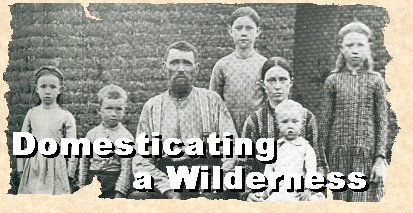
|
Episode 7 Directed by Tim Slessor "In a comfortable house in New York, Walt Whitman, in his old age, thought back to the West of his youth: 'the enormous skies, the ramparts of the mountains, the uninhabited silence, the ocean of sage, and ever the cowboy with his broad-brimmed hat, with loose arms raised, and swinging as he rides.'" |
The first Westerners crossed the continent to reach the Pacific shore. However, some of the first people to settle in the interior of the country were the Mormons (the Church of Latter-Day Saints), who were persecuted in the East for their religious beliefs. Salt Lake City, Brigham Young, and the history of the church and settlement are profiled by Cooke, from the city's founding to the present day.
Next Cooke touches on improvements of the railroad and locomotive that spurred the next wave of settlement. The transcontinental railway, built by Southerners and Irish in the east, mainly the Chinese in the west, struggled against nature and weather and finally joined in Promontory Point, Utah, May 10, 1869. "The annexation of the United States" was heard around the country via another recent invention, the telegraph. Railroad branch lines sprang up and became centers for new industries, such as the next city profiled by Cooke, Abilene, Kansas, which became a railhead for cattle distribution. The legend of the cowboy—and the gunslingers—had begun.
Mining boomtowns appeared and disappeared, but then permanent residents were encouraged. Some foreigners even came to the West for a lark, like the settlers of Victoria, Kansas, founded by Englishmen. But most, mainly immigrants from Europe, struggled on the plains against the freakish weather, the wind, and loneliness. At the boyhood home of Dwight D. Eisenhower, Cooke tells of the homesteaders who introduced the family to the prairies and the West, the civilizing force of mothers who finally "tamed" the wilderness with homes, furnishings, a horse and carriage, and churchgoing. These farmers came into conflict with the cattle herds, and the humble barbed wire fence beget range wars and ultimately turned the free-range cowboy into a rancher.
The hour closes with Cooke's examination of the fate of the Native American population. In 1889, in the great land rush, the Indians lost their last big claim, Indian Territory, which became the state of Oklahoma. They had been pushed west, chivvied into reservations on arid lands, and made to be dependent on the government, with occasional uprisings such as the massacre of Custer's 7th cavalry. In 1890, the last Indian uprising took place and the cavalry took its revenge at Wounded Knee, South Dakota. The Indians were subdued and the "Wild West" descended into myth.
Locations:
Eisenhower Home, Abilene, Kansas
Pine Ridge Reservation, South Dakota
Whitney Gallery of Western Art, Cody, Wyoming
Mormon Tabernacle, Salt Lake City
Southern Pacific Railroad, Sacramento, California
and the states of Kansas, Nebraska, Utah and Wyoming
_________________________________________ There is a great use of music and archival photographs of frontier families to illustrate the range wars and the hardships of the settlers of the plains. Cooke's stories about the Englishmen and Russians who formed their respective settlements—Victoria and Catherine—were especially intriguing.
PERSONAL NOTE ON A PERSONAL SERIES:
![]()
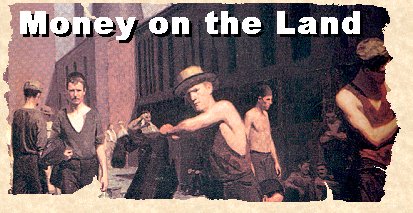
|
Episode 8 Directed by David Heycock "If we retrace the steps by which America went from a wilderness to a giant of technology, there are less than fifty years from the homesteader growing his food on the 160 acres the government had given him to mammoth factories processing and packaging food for this nation and other nations. Less than half a century from a village on the prairie to the first city of the plains, the phenomenon of Chicago." |
Most Americans, comments Cooke, tend to remember Chicago from the Great Fire and the gangsters of the 1920s. He opens this episode in that city, which began as a fur-trading post; dredging a sand bar in the port gave it a harbor, which, along with the railroad, turned Chicago into the biggest grain market and eventually stockyard and railroad center of the world.
But the railroads and the prairie also changed the idea of the stalwart yeoman farmer making his own living. Machines appeared to make farming an industry; by the end of the century, the small farmer became almost a relic. Cooke then gives us a tour of Thomas Edison's laboratory, to show us what the young people of the late 1800s craved: the new inventions of the day, not only those that were work related, but things like Edison's other creations: the phonograph, the electric light, the "Kinetograph" (the movies), etc. In that period, inventions came in droves: the telephone, the personal camera, the sewing machine.
We are then taken to Pennsylvania for the next development: petroleum drilling began in this state after what was known as a native remedy for constipation also proved it could be refined for use as a lighting fluid (kerosene) and later as a lubricant and fuel. Until refineries proved profitable, even John D. Rockefeller did not believe in the future of oil—then his monopoly of oil refineries made him a millionaire and then the first billionaire in history. Others with the gift of moneymaking appeared: Henry Clay Frick, Andrew Carnegie, John Pierpont (J.P.) Morgan, whose residences Cooke visits. Carnegie homself was a true American success story: from Scottish bobbin boy at thirteen to a billionaire in the steel industry by middle age.
These men donated enormous amounts of money away to charity, but lived in a prolifigate manner—epitomized by the "summer cottages" in Newport, Rhode Island—while other Americans, many of them workers of the "money barons,'" lived on minimum wages in squalid conditions in slums while toiling in factories or mines. Worse, the farmers who fed the country were now in debt to the railroad magnates for shipping their grain and the providers of the machinery for their harvests. Cooke profiles their champion, William Jennings Bryan, who unsuccessfully ran for the presidency.
Locations:
Commodity Exchange, Chicago
Santa Fe Stockyards, Chicago
Union Stockyard, Chicago
Homestead National Monument, Nebraska
Holsum Bread Factory, Chicago
Edison Institute, Michigan
Drakewell Memorial Park, Pennsylvania
Museum of the City of New York
Humble Oil and Refining Company, Louisiana
Skibo Castle, Scotland
U.S. Steel, Pennsylvania
Marble House, Rhode Island
William Jennings Bryan House, Nebraska
_________________________________________ The "Edison Institute" is part of Greenfield Village and the Henry Ford Museum in Dearborn, Michigan. It was brought there intact by Ford in establishing Greenfield Village, which also includes a boarding house used by Edison's employees, with its early electrical wiring. The Marble House, with its ballroom layered in solid gold, and other of the Newport "cottages" can be toured, a revelation to see what luxury they had for seven brief weeks a year.
PERSONAL NOTE ON A PERSONAL SERIES:
![]()
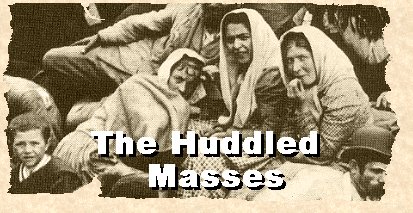
|
Episode 9 Directed by David Heycock "We think of New York as the capital of banking, publishing, business, entertainment, fashion--the high life. But to most of the people who live here, it is—or was—the capital city of the exile." |
In this episode, Cooke traces the history of the immigrant in America, mostly during the latter half of the 19th century and the first part of the 20th, many seeking sanctuary from hard times in the homeland. The potato famine sent the Irish to America. Other European immigrants came due to political upheavals; the Jews fled from pogroms. The legend still persisted that "America was paved with gold."
The immigrants' journey inevitably began, as Cooke illustrates, in a rough train to a port city with as many possessions as they could carry. Bathed and fumigated, they sailed, cheek-by-jowl in steerage, to American port cities, most to New York where they endured one more ordeal: the examination at Ellis Island. Cooke traces this process in detail. Most of them feared deportation by disease. Those who passed, eight out of ten, were questioned, then given a landing card.
Once they settled into their own ethnic neighborhood, they still had problems with coping with the new world. Some went to advice societies run by their own ethnic groups. The Jewish people had a newspaper that aided the immigrant, The Jewish Daily Forward, the last Yiddish newspaper in the United States. But immigrants got their greatest aid from the local politicians, who exchanged your vote for favors. Cooke tells us stories about these "ward bosses," like George Washington Plunkitt, some who worked 18 hours a day hustling votes by helping tenement dwellers find jobs, fight judges, and hustle landlords, and who reveled in what they called "honest graft."
Cooke then steps into the theatre to show how burlesque became an escape for lonely immigrants, who were also entertained by the new "comic strips" and ethnic humorists. Cooke also shows us what they were escaping from: poverty jobs that paid little for long hours and dirty tenement homes that put more funds into the pockets of the rich like J.P. Morgan, collector of treasures such as original manuscripts. The business monopolies were finally brought down by Theodore Roosevelt, who was the first President to realize that American was no longer an agrarian society but a industrial nation ruled by the likes of Morgan and Andrew Carnegie.
Cooke then speaks of assimilation. For the children of immigrants, schools became the place where they learned to be American, but these children soon became ashamed of their parents' accents and ethnic manners. Therefore adults began going to school to learn English and become American citizens.
Locations:
di Bella Brothers Foods
Department of Justice
East Midwood Jewish Centre
Eden Theatre
Gary Focks
Jewish Daily Forward
La Marquela
Manhattan Public School 150
Office of Fundamental Adult Education
Pierpont Morgan Library
Sagamore Hill National Historic Side, Oyster Bay
Statue of Liberty National Monument
Stevens Institute of Technology
_________________________________________ As the grandchild of immigrants, this is another favorite episode. At the time Cooke toured Ellis Island, it was still abandoned; the restoration work I've seen compared with what was shown is astounding. I enjoyed Cooke's reading of the Milt Gross story about Columbus as well as his humorous explanation of the conventions of vaudeville; the section about George Washington Plunkitt is particularly interesting.
PERSONAL NOTE ON A PERSONAL SERIES:
![]()

|
Episode 10 Directed by David Heycock "'Blessed is the man that feareth the Lord. His seed shall be mighty upon the earth; wealth and riches shall be in his house.' When John Winthrop, the first governor of Massachusetts, founded in the 1640s the Puritan society of New England, he laid it down that the economic failure of a Godly society was a sign of God's curse." |
Following World War I, the United States became a prosperous world power; Cooke tells us that the business success of the 1920s was hand-in-hand with the precepts of John Winthrop, who believed that reverent hard-working people were rewarded with fiscal prosperity. The country had just emerged from "making the world safe for democracy" in the First World War, but while Woodrow Wilson attempted to further democracy in Europe, all the Allies wanted was reparations. Then, as a Bolshevik scare swept the country, Wilson fell into disfavor for consorting with Europe. Americans wanted no more to do with "the old world" and chummy Warren G. Harding was elected.
Harding, briefly profiled, died in office after letting his chums rob millions from American coffers, and was succeeded by Calvin Coolidge, a taciturn Vermonter who later declared "the business of America is business." He believed in as little central government as possible and industries flourished in "the Coolidge prosperity." Cooke tells about the two boons to the beleaguered farmer in those prosperous times: the cheap Model T created by Henry Ford and the mail order catalog.
Cooke then examines the frivolity of the 20s that have passed into history; Americans went in for superlatives, in sports and in other events; in 1927, Charles Lindbergh became a hero. Gentleman golfer Bobby Jones was another figure lionized as much for his integrity as for his skill. As society became freer, sex themes drenched the movies and plays, and morals were loosened by hip flasks filled with gin. Liquor was illegal due to Prohibition, instituted after the war, but it not only did not inhibit drinking, but brought the rise of mob bosses who were previously petty gangsters. As prosperity continued to boom, advertiser Bruce Barton wrote a bestseller and declared Jesus to be the very first advertising genius and the founder of modern business.
Coolidge declined to run for office in 1928. Cooke talks about how his successor, Herbert Hoover, took the complete blame for the economic crash in 1929 that brought on the Great Depression, but that the trigger for this crash had been building during the Coolidge administration by people buying stocks on margin.
The unemployment and hard times of the 1930s is then profiled. Factory workers and businessmen alike were out of work. "Hoovervilles" populated by the unemployed sprouted outside cities. Farmers starved and the Dust Bowl—with some frightening footage of the dust storms shown—consumed the wheat-growing areas. They were all "saved"—although some political analysts argue otherwise—by wellborn Franklin D. Roosevelt, disabled by polio. Cooke reviews his recovery programs and his NRA policies, which were considered socialistic by many; most were eventually overruled by Supreme Court.
Locations:
New York Stock Exchange
Winthrop Theological College, South Carolina
Warren Harding Home, Ohio
Calvin Coolidge Homestead, Vermont
Smithsonian Institution, Washington, DC
Augusta National Golf Club, Georgia
Gaslight Club, Chicago
Episcopal Church Centre, Chicago
Hyde Park, New York
Inland Steel, Chicago
_________________________________________ A lot is squeezed in one episode, but it's done so well. This is the era my parents grew up in; I could see many of their stories in Cooke's Depression tales. The commentary about "wild youth" and sexual repression was particularly amusing.
PERSONAL NOTE ON A PERSONAL SERIES:
![]()

|
Episode 11 Directed by David Heycock "These war games [scenes of aircraft carrier] are being practiced in the Pacific Ocean off the coast of California, and somewhere, across thousands of miles of blue water, the Russians, no doubt, are doing the same. For a quarter of a century now, the rest of the world has looked on, sometimes with relief, often with dread, at the increasing and competing might of the two superpowers. It's assumed by most people everywhere under 40, I should say, that America has always been a military mammoth; on the contrary, one of the most doggedest traditions of the United States through its first 160 years was a distrust of a permanent armed force." |
The episode opens with scenes of war games being carried out on a U.S. aircraft carrier. Cooke then turns back the clock to tell us how the United States became an "arsenal of democracy." In the early years, we are told, from after the Revolution, the colonists distrusted standing armies and they were dismissed. Technically each colonist who owned a firearm was part of a militia, which would arise only if trouble occurred. Then the Marine Corps was formed to protect American shipping against pirates and privateers. Next the cavalry was formed to protect Western settlers. But except at wartime and even after World War I, the American Army was small.
Cooke's narrative now turns to Europe, as Hitler begins marching across that continent. The United States sent weaponry and ammunition to Great Britain as the "Arsenal of Democracy," since President Roosevelt believed if England fell, Hitler would then set his sights on America. Isolationists fought against involvement in another war—until the Pacific fleet was blasted at Pearl Harbor by the Japanese. World War II suddenly became "our war" and factories outproduced the enemy.
Cooke then profiles Henry Kaiser, who changed the shipbuilding process and whose mass-produced, servicable if ugly "Liberty ships" helped deliver supplies and troops. In the Pacific, ships and troops inched along islands to press back the Japanese. Yet victory in the Pacific was born in Europe: Cooke talks about the leading physicists who had fled from Hitler's persecution, including Einstein, Teller, and Fermi, who worked on the Manhattan Project, the production of the atomic bomb. Cooke then tours the old Los Alamos site. The bombs tested here shattered Hiroshima and Nagasaki to prevent the loss of one million American lives it would have cost to invade Tokyo.
Cooke now talks about the formation of the United Nations, originally founded with five major powers presiding; it became clear when it opened that there were only two major powers, the United States and the Soviet Union. The Soviets had exploded their own atomic bomb in 1953 and fear of spies was rampant. Treaties were eventually signed with other countries with the promise of defense, including use of the atomic bomb, which eventually led us into Vietnam.
A tour of Strategic Air Command headquarters in Omaha, Nebraska, showing how our country is defended—the "Minutemen" still exist—closes the program.
Locations:
United Nations Building, New York
Fort Myers Stables, Washington, DC
Arlington National Cemetery, Washington, DC
U.S. Marine Corps Barracks, Washington, DC
Raleigh Tavern, Williamsburg, Virginia
Fort Eustis, Virginia
Charleston Submarine Base, South Carolina
Strategic Air Command Headquarters, Omaha, Nebraska
Sandia Atomic Museum, Albuquerque, New Mexico
Los Alamos Scientific Laboratory, New Mexico
Trinity Site Base Camp, White Sands, New Mexico
Dog Canyon, Hr. Alomogordo, New Mexico
Beale Air Force Base, Marysville, Calfironia
Vandenburg Air Force Base, Lompoc, California
U.S.S. Oriskany (aircraft carrier)
_________________________________________ The "Looking Glass" is now a curiosity; the flights no longer exist. But at one time they were so well known that even a Lassie episode involved a "Looking Glass" flight.
PERSONAL NOTE ON A PERSONAL SERIES:
![]()

|
Episode 12 Directed by Ann Turner "This is the grand and glorious clichè of America [New York City shown], as the Acropolis is of Greece and the Taj Mahal of India. A million tourists have said there's nothing like it, and they're right. Many more millions of Europeans got their first view of it after the long steerage journey from Ireland or Italy or Russia. I was lucky; I came by choice." |
Alistair Cooke came to America, after having graduated from Cambridge and being offered a fellowship at Yale, with conceptions formed from childhood. Upon exploring the country and getting to know the people here, these are the things that he most admired:
Locations:
New York City
New Orleans, Louisiana
New Fane, Vermont
Mayo Clinic, Rochester, Minnesota
Point Lobos State Reserve, San Francisco, California
Harvard University, Massachusetts
Hingham Churchyard, Massachusetts
Enoch Pratt Free Library, Baltimore, Maryland
Zion Canyon National Park
Bryce Canyon National Park
_________________________________________ This is my absolute favorite of the episodes. It's fascinating to see what attracted a person from another country to live here voluntarily. His story about the Mayo family and the founding of the clinic is fascinating, and his profiles of H.L. Mencken and "Emperor Norton" are quite entertaining.
PERSONAL NOTE ON A PERSONAL SERIES:
Incidentally, when the series aired in Great Britain, "The First Impact" was shown first, rather than next-to-last. I have used the U.S. broadcast order here, but, chronologically it makes a lot more sense for "The First Impact" to be the opening episode.
![]()

|
Episode 13 Directed by Michael Gill "About a fifth of America, half the West, is semi-desert; for centuries much of it has been at the mercy of the Colorado River, which is either a trickle that leaves the land parched, or a torrent that floods it with silt. The desert is not infertile; spit on the desert, they say out west, and a flower will grow. Here on the Arizona-Nevada border is one of the great works of man, Hoover Dam, which bottles the 14-hundred mile flow of the river and teaches it to spit accurately and often on one quarter million acres of dry land." |
Cooke tours Hoover Dam, "built before plastics and lavatory tile" to give Americans of the West "the more abundant life," and which made Las Vegas possible. Here he contrasts life of the 1970s against the dreams and ambitions of the original American settlers.
Americans, declares Cooke, have a knack for creating businesses by creating a need for a luxury product. His example is Frederick Tudor, who founded the ice business in America and then abroad; he creating a market for ice where there had been none before.
After World War II, a dramatic change came. While cities grew and property values flourished, people left urban areas to live in the suburbs. Green farmland like the San Fernando Valley turned into housing projects; automobiles spread smog over the cities.
In the 1970s some younger people rejected the suburban lifestyle by moving to communes in the country or becoming involved in different religions or groups. Some of these harken back to groups like Robert Owen's New Harmony. Other people escaped to "gated" communities.
Some of those who fled to gated suburbia unfortunately were escaping the cities to flee from minority groups, in the 1970s primarily African-Americans (also Puerto Ricans). In the past "separate but equal" facilities were offered for blacks and whites, but were not equal for those of color. In the 1950s the Supreme Court overturned this decision, but integration was slow in coming, inspiring the riots of the 1960s. Cooke admits that he does not know the answers for the problem; that the only chance is that white persons must change their perspective.
He believes that most of us still subconsciously think that westward the land is brighter—to that end Cooke visits Hawaii, where he sees hope in a more relaxed lifestyle and intermarriage within races, although the setbacks of the modern world have already reached the islands; the native culture has been absorbed or diluted, and there is pollution and some urban sprawl.
Cooke sums up in the end, comparing the United States to Ancient Rome, whether American culture is still in ascendency or in decline. His statements about society in the 1970s still hold true today.
He closes with these quotes about what he has learned during half a lifetime of living in the United States:
"A Constitution is made for those of fundamentally differing opinions."…Justice Oliver Wendell Holmes
"There is no free lunch"…Italian immigrant, asked what 20 years of life in America had taught him.
Locations:
American Express Headquarters, Phoenix, Arizona
Elysium Institute, Topanga Canyon, California
Westlake Village, California
Moonfire Mountain, California
New Harmony, Indiana
Hoover Dam, Nevada
Las Vegas, Nevada
Canaan, New Hampshire
Howard University, Washington, DC
and in Chicago, Los Angeles, New York
and on the islands of Oahu and Maui, Hawaii
_________________________________________ Even at the time of broadcast, this was my least favorite episode. Cooke says at the beginning that most historians usually stop their narrative before the present time, but he wanted to address modern America and some of its problems. IMHO he missed the mark. It dated the series and, to me, sounded rather presumptuous. I would have preferred a continuation of the Cold War narration that began in "The Arsenal" and something about the 1950s and 1960s American society in general—the rise of teenagers as consumers, for instance, or McCarthyism, television becoming an influential force in political decisions, etc. The Civil Rights movement was the only pertinent section; it would have fit with a narrative such as the one suggested and might have sounded less didactic. Still, the other episodes are so outstanding that this one's faults can somewhat be forgiven.
PERSONAL NOTE ON A PERSONAL SERIES:
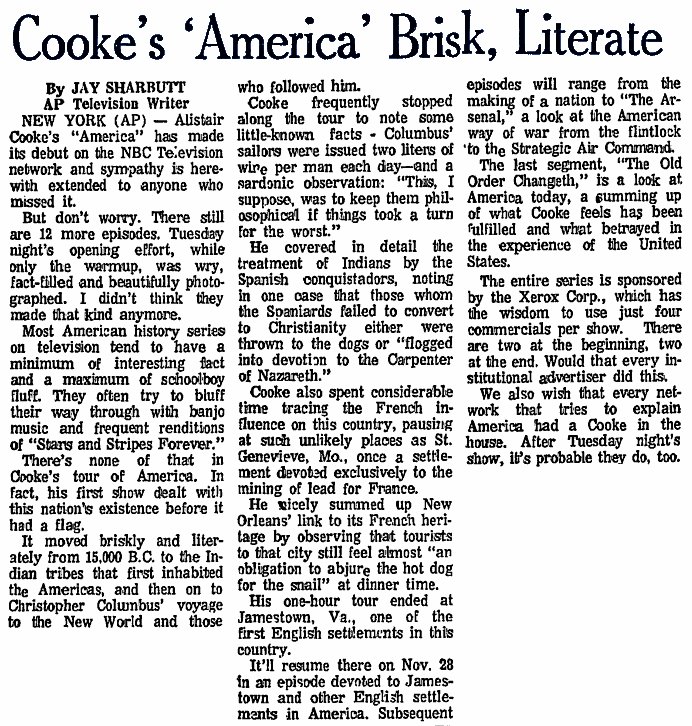
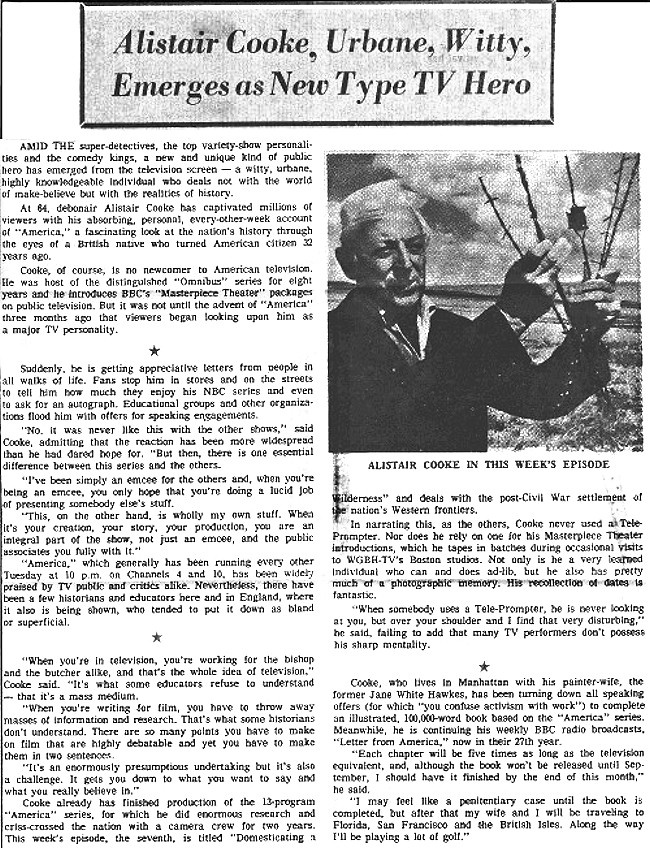


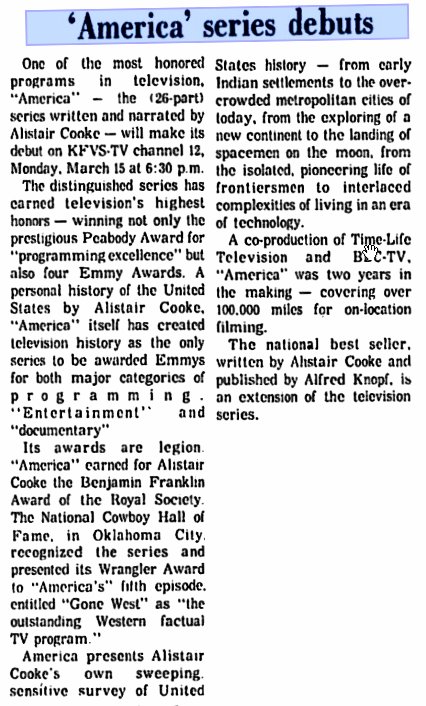
| America, a Personal History of the United States by Alistair Cooke is the property of Alistair Cooke and BBC Television. This is a fan page. No copyright infringment is intended. Any opinions stated are my own and do not reflect the thoughts of the creators or producers. |
![]()